Compositional Uses
of The Crossing Phenomenon In Recent Music
Gerald
Ruffertshoefer Gabel
The
evolution of musical stylistic traits from one era to another has, in part, been
achieved gradually through a particular treatment of musical elements or phenomena
which had been either avoided or unrecognized in previous epochs. For instance,
dynamics were not indicated in music until the early Baroque. Once it was
recognized that composers could more accurately depict a musical idea through
their use, dynamics became an integral force in the shaping of
musical materials. The manner of their implementation contributed to the
characterization of musical style in succeeding centuries.1 Similar evolutionary tendencies
have occurred in relation to other musical elements.
While
engaged in a study of musical texture, it was found that the phenomenon
of "crossing" was being utilized to a greater extent in this century
than in times past. While it is difficult to say that crossing is
characteristic of 20th century musical style, one can argue that its use is important in
the music of composers such as Webern, Xenakis,
Ligeti, Lutoslawski, Nancarrow, Debussy and others. For instance, part crossing occurs
with such regularity in the rhythmically free sections of Lutoslawski's orchestral works that it may be considered a feature of his compositional language. Crossing implies the intersection
of musical phenomena to such a degree
that their relative placement is reversed. Perhaps the most common form is part crossing.2 In this case, the
relative pitch ranges of two or more parts are reversed; the lower part becomes the higher part and the
higher becomes the lower. While it is true
that the crossing phenomenon is seldom employed as a focal structural .element
in the compositional process, the
numerous examples of its use in this century suggest that it is an
exploitable phenomenon which is worthy of observation and discussion.
Since the
crossing of two melodic lines is somewhat common in music from previous
centuries and since the aforementioned article addresses common practice usage;
this paper will focus upon examples from the present century which provide new
insights into the use of the crossing phenomenon. Specifically, part crossing
will be discussed in the context of unorthodox contrapuntal
settings. This will include examples which exhibit atypical melodic construction,
unusual contrapuntal interaction between component lines in a texture, and the
production of part crossing in textures
which feature the accumulation of many component lines (mass-like textures).
There are
also several musical phenomena besides pitch which have been subjected to
treatment, similar to part crossing. One is a technical device utilized in
piano literature
in which the hands physically cross one another. A second technique is the use of different
tempos in concurrent lines. At a designated point in the unfolding of the
composition, each tempo may articulate beat 1 of
a measure simultaneously. Then, due to the
differing temporal rates, they will digress from one another again. One may think of this as a temporal crossing in the formal
sense. There is another crossing
phenomenon that is closely related to temporal crossing. One may create the
illusion of increasing tempo without a tempo change. This is achieved by
decreasing the duration of notes within a line. The pulse remains constant, yet
the increasing linear density of articulations, for example, causes the
sequence to accelerate. A third technique, which
is found only in twelve-tone and serial musics,
features the crossing of various farms
of a row. Finally, the phenomenon of crossing has been extensively applied to the
movement of sound in
musical and physical space.
Part Crossing as a Product
of Unconventional Contrapuntal Procedures.
After the
Baroque era, counterpoint became of secondary importance to harmony as the
focal point of structural organization in music. By the turn of the twentieth
century, tonal practice had been stretched to the point that composers had
begun to search for alternative modes of construction which
would instill their creative endeavors with new vitality. One of the primary
developments was the gradual re-implementation of contrapuntal devices. As the harmonic
vocabulary became more inflected and the limits of tonality tested to the
extreme, greater emphasis was placed on linear relationships in order that composers might
maintain adequate control over compositional materials. This "reactivation of the
polyphonic evolution" took place primarily
in the music of Arnold Schoenberg and his disciples Anton Webern
and Alban
Berg.
Anton Webern's music portrayed an extended view of the traditional
contrapuntal implications found in Schoenberg's music. The lines
that make up Schoenberg's textures were constructed according to traditional
rhythmic percepts, were distinguishable as independent lines, and were combined
according to traditional considerations of complementary rhythm. Schoenberg's treatment of
the row was thematically oriented. On the other hand, Webern
utilized it as a more abstract phenomenon and did not view it as a source for
melodic construction. In fact, he tended more towards condensation and
fragmentation (or athematic construction)
particularly in terms of rhythm.
It is
important to consider the extent to which linear elements can be called lines in Webern's music. Example 1, extracted from the first
movement of the String Quartet, Op. 28, illustrates
the angular and fragmented nature of his "melodic" construction.
Not only are the two note groupings indistinguishable as lines, but they are separated
by internal silences of equivalent duration, further inhibiting their perception as lines.
Instead of a texture of lines, one finds a texture which is frequently called " pointillistic." The
paradox is that even though we are dealing with music that is strictly
canonic, it cannot be called contrapuntal in the traditional sense. Although
Example 1 is set in canon, one hears only a series of independent two note
groupings. Having been integrated as an important structural element,
the silences disrupt not only
the sense of linearity but also the sense of contrapuntal flow.
There was
also a marked tendency towards angularity (disjunctness)
in Webern's use of intervals linearly. This resulted in part
crossing. Webern's use of angularity
contributed to a lack of separateness and, thus, to the equivalence of parts. Through the
initial viola entrance in Example 1, the domains of the parts remain relatively distinct with minimal
incursion from each other and no instances of crossing.
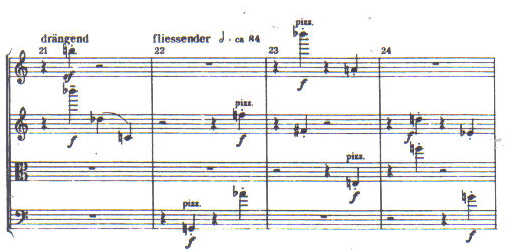
Example 1: Webern's String
Quartet, Op.. 28
First
Movement, mm. 22-24
Copyright 1939 by Hawkes
& Son (London) Ltd., Copyright assigned 1955 toUniversal
Edition A.G., Wien. Copyright renewed. All rights
reserved.Used by permission of European
American Music Distributors Corporation, sole U.S. agent for Universal Edition.
In the third measure, the situation
alters noticeably. On the second beat, the viola (F5)4 crosses the second violin part (D5).
This is immediately followed by the violoncello (G4) crossing with the second
violin (E flat 4), significantly affecting their relative placement. The combination of angular intervallic
successions and pointillistic texture creates a considerable number of crossings. Without a
doubt, Webern utilizes the technique
to such an extent that crossing may be considered characteristic of his style.
Part
crossing may also create a lack of separateness even in textures which feature a more traditional melodic design. Beginning in
m. 52 of my Saraph for Three Bassoons (Example 2), lines one and three engage in a two measure passage which features a predominance of wide skips. Unlike Webern, this example does not feature skips beyond the octave, nor are rests functional in the
melodic construction. Nevertheless,
one confronts a similar unrelenting invasion of the parts into one another's pitch domains. In fact, the domains of the two
parts are virtually the same. Until
the third beat of m. 53, they do not engage in crossing to any appreciable
degree. On the first beat
of m. 53 the first part does supersede the third. Since they had only engaged in a unison up to this
point in the example, it is premature to call this a crossing since the first line returns to the unison before any
pitch change in the other one. Beginning
with the fourth beat of m. 53, they begin a series of crossings which culminate
with the return of the original Unison. Due primarily to the number of unisons on the pitch E flat 4, they never achieve melodic
independence. This is evident even prior to the point at which they engage in crossing. The singular nature
of the shared domain coupled
with the persistent articulation of a unison and subsequent crossing, lock them
into a singular identity; a complex, angular texture with Eb4 as the focus of pitch
activity.
Another
example of crossing in an extended contrapuntal setting is found at rehearsal 24 of "Repos dans le Malheur" from Trois
Poernes d'Henri Michaux by Witold Lutoslawski (Example 3). The texture is
characterized by a plethora of crossings which are achieved through the massing technique. It involves the
accumulation of, at times, an
extreme number of independent, imitatively conceived parts (in this case 20).
In effect, the individual attributes of each line are subsumed into a global identity: the texture of the passage. The domains of the
vocal sections within the choir overlap
considerably. However, each choral section contains five lines which evolve independently of each other. Lutoslawski called this "collective ad libitum." By
this process, each performer proceeds at his own pace.
In the performance instructions Lutoslawki
writes:
The duration of the notes is in general free, except for
those having pauses, which should be longer
than the others. The greatest naturalness in sound-production and interpretation is recommended. Thus, the more difficult
intervals may be attacked slowly and the
easier ones more quickly. The performance of the whole section, however, should be free of haste, for which reason the
duration of the individual notes should not be less than 0.5
seconds.5
One can expect significant part
crossing within each choral section as well as between them. Following individual lines is impossible under such
circumstances, which, in this instance, is
the desired result.

Example 2: Gabel's Saraph for Three Bassoons, mm. 52-54
The Application of the Crossing Phenomenon to Elements
Other than Pitch
Claude Debussy
utilized the technique of hand crossing in his keyboard music. However, he did not always maintain distinct
placement of the domains in which the hands'
parts were played. As a result, they often overlapped or shared similar (at times
even the same) domains.
In
the third movement of Images
I for piano
(Example 4), the left hand harmonic
support encompasses the domain of the right one. In measure six (on the fourth beat), the domain of the
right hand part extends a whole step beyond that of the left. In m. 9, the harmonic material shifts to the
right with the melodic line belonging
to the left hand. In this instance, the melodic line maintains the low and high portions of the passage's pitch range while at the
same time passing through the interval
of a perfect fifth outlined in the right. In m. 16, the functional role of each
hand again reverses with the right assuming the melody and
the left the harmony. Debussy
has thus not only allowed the hands but also the harmonic and melodic functions
to "cross."
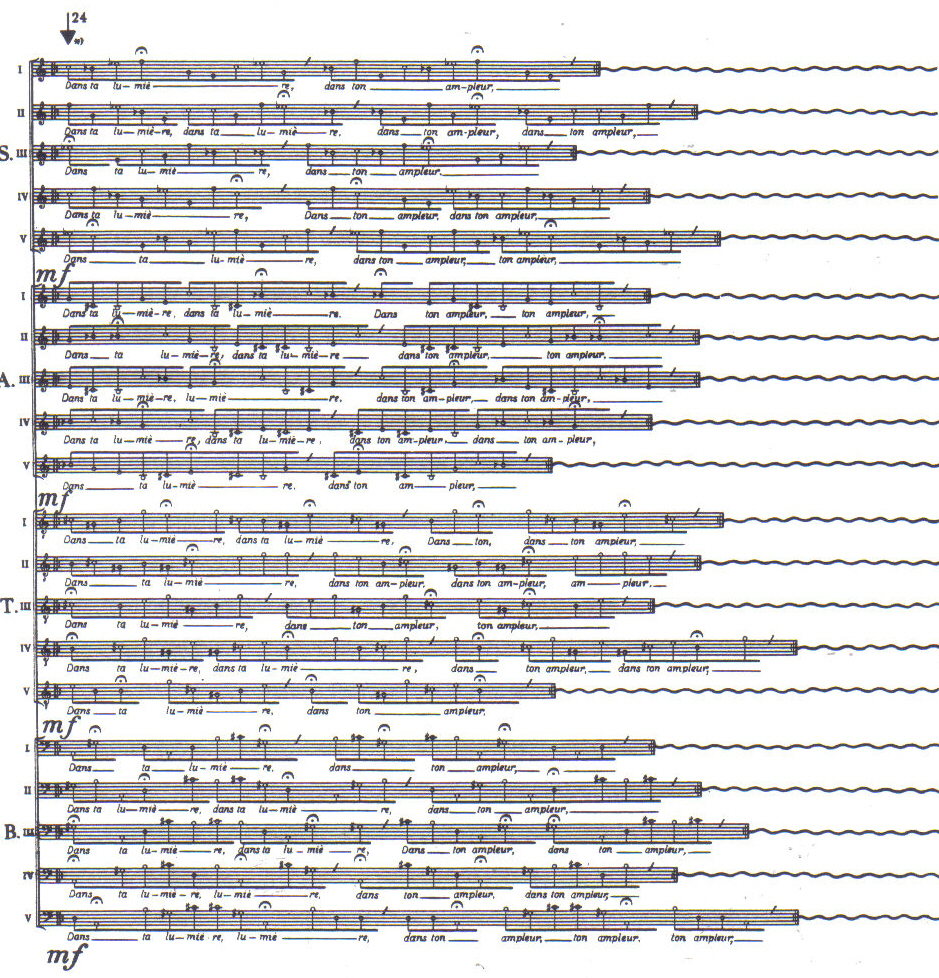
Example 3:
Lutoslawski's
"Repos dans le Malheur"
from Example 3 of Lutoslawski's "Repos dans le Malheur" from Trois Poemes d'Henri Michaux, Rehearsal
numbers 24-25
Reproduced by kind
permission
of the copyright owner, & W Chester/Edition Wilhelm Hansen
London Ltd.
Webern's
Piano
Variations, Op. 27 is an excellent example of the
extended use of crossing. Two types are found in the work: row and hand
crossing. The second movement (Example 5a)
is a strict canon in contrary motion. The subject begins in the left hand and
is imitated at the temporal interval of an eighth note in the right. The original form of the row is found in the
right hand (01) at the beginning of the movement. A cursory look through the example reveals that the last note
of the realization of one row is
simultaneously the first note of the realization of the next row form in the same hand. The hand in which a particular sequence
of row realizations appears
changes in five places: measures 5, 6, 8, 17 and 18. Each of these crossings produces
a change of function for the rows. In each case, the subject row becomes the countersubject row and vice versa. Additionally,
as the first main section is repeated there is a crossing of the function of
the entire sequence of rows found in each hand. In the initial pass, the sequence of rows indicated by
a solid line begin in the right while
those indicated by a dotted line are found in the left. At the end of this
section this arrangement has been registrally
reordered. Therefore, the repeat will begin with the "dotted line" in
the right hand and the "solid line" in the left and end as the piece began. Ideally, the second main section should
begin with the "solid line" sequence of rows in the right and "dotted line" in
the left. However, for clarity in viewing the unfolding of the rows, it was decided to overlook the repeat at the end
of the first main section. Therefore, the actual row sequences for the
hands are reversed. It is possible that,
since he was not prone to repeating entire sections of a composition, Webern purposefully employed the technique of crossing the row
sequence in order to provide
a structural distinction between the original statement and repetition of both sections
of the movement.

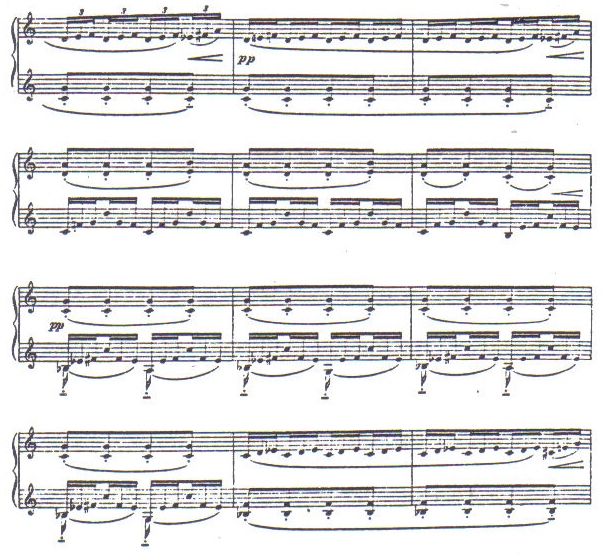
Example
4: Debussy's Images I,
Third Movement, mm. 1-17
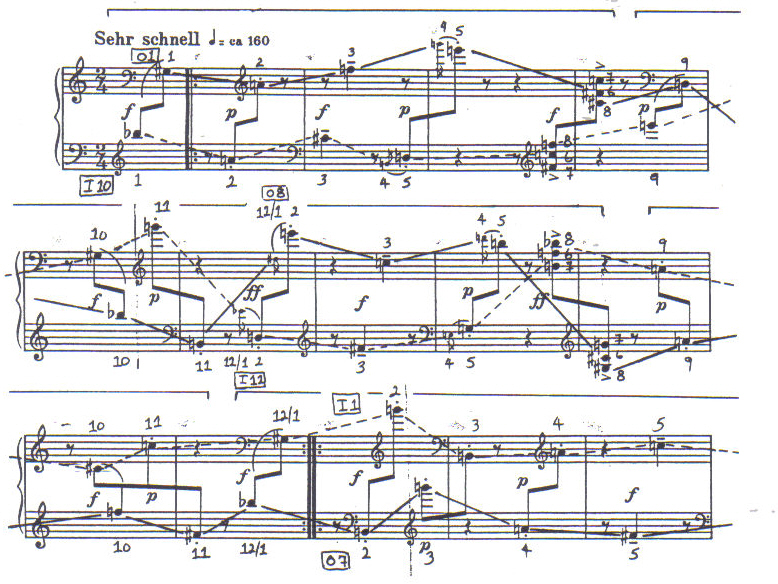
Example
5a: Webern's Piano Variations, Op. 27
Second Movement mm. 1 - 14
Copyright
1937 by Universal Edition. Copyright renewed 1965. All rights
reserved. Used by permission of European
American Music Distributors
Corporation, sole U.S. agent for Universal Edltion,
It is a curious trait of Webern's choice of row forms that specific pitch classes in one row always appear in conjunction with specific pitch classes in another row form. As a result, only seven
pitch class diads are formed. They are B flat-G#, B-G, AA,
F#-C#. E flat-D#,
E-D, and C#-17. However, the
succession of these diads changes with each
combination of row forms. Therefore, symmetrical palindromes made up of
these diads do not occur in the movement.
Another focal point in this work lies
in the extension of piano technique through hand crossing and the alternation of the order in which hands
articulate events. In
Example 5b, both of these relationships are shown. Solid vertical lines indicate changes in the order in which the hands
articulate events (i. e., from left-right to right-left or vice versa). The full implications
of this phenomenon are not shown
in the example as only relative pitch ranges are included. There are, points
(for instance, measures 12 and 13) at
which hands must cross to opposite ends of the piano.

Example 5b: Webern's Piano Variations, Op. 27
Hand
Crossing in the Second Movement
In
Anton Von
Webern:
A Chronicle of His Life and Work, Hans
and Rosaleen Moldenhauer
clarify Webern's reason for including hand crossing
in the Variations:
Dwelling on some of the pianistic
details of the work, Stadlen6 referred to the awkward
crossing of hands demanded for the proper execution of of the Scherzo movement movement:
'Webern said that the inevitable difficulty in bringing it
off would invest it with just
the
right kind of phrasing.7
In Example 5a, brackets indicate phrasing based upon Weliern s implementation of hand crossing. Each phrase includes a hand crossing
followed b a reversal of direction to
another crossing thereby re-establishing the placement of the hands encountered at the beginning of the phrase. Therefore, phrase
#1 is wade up of five successive diads, the next phrase by the next seven diads, and the final phrase of the first half of the work
by three dials. The 5 + 7 + 3 construction
is reflected in the second half
although with 'a subtle change. The final diad before
the repeat in m. 11
serves simultaneously as the beginning of the
repeat and as the beginning of the second half of the work. However, the second half, as notated, begin N after the repeat. For phrasing purposes, the fourth phrase begins in m. 11 but the hand
crossing pattern begins at in. 12. With this in mind, the grouping of diads.
into phrases in the second half is 6 + 7 + 3. Webern, then,
had at least two reasons for the sectionalization of this movement. First, the phrase structure (which is conditioned by the ordering of hand crossing) divides it into two groups of three
phrases. The ordering of phrase lengths provides a sense of unity in the first,
half of the movement. Secondly, the row
crossings provide the means by which both halves of the work are repeated. Therefore, crossing principles as related to row
manipulation and phrase structure provide
a tactic for formal sectionalization and unity in
this movement. Unity is also achieved through the
implementation of the limited number of diads.
Unlike Webern's exposure of musical elements to crossing at
various structural levels, Conlon Nancarrow
crosses four tempos in his Canon #36 ( 17 / 18 / 19 20 ) (Example 6a).
Nancarrow's music is important in that not only does
he establish tempo as the primary temporal element but the tempo
relationships themselves are often the modus operandi of his compositional
inspiration. In his article "Inexorable Continuities," Roger
Reynolds wrote:
There is a tendency to think of a musical
element 'rhythm' as though it included
meter
and tempo (in the sense that they are supportive conditions over which rhythmic
invention takes place). Nancarrow, however, seems to identify
tempo as
the prime
temporal consideration and to relegate other time-related elements to lesser
status.8
Each of the four lines in Canon #36 possesses a tempo
distinct from that of the other parts.
One line progresses at the rate of a whole note equaling
MM=85, another at MM=90, the
third at MM=95, and the last at MM=100. The ratio of these tempi is the ratio in the title of the work (17/18/19/20). In the
time it takes for the MM=85 line
to progress through 17 measures, the MM=90 line will have stated 18 measures, the MM=95 line 19 measures, and the MM=100 line 20
measures. At this point, all four
parts articulate beat 1 of their next measure simultaneously. There will not be
another simultaneous articulation of
beat 1 in any measure until the cycle has been re-stated. Once all four lines have entered, there are 33
statements of the cycle after which
they one at a time drop out in the reverse order in which they entered. The incessant implementation of the temporal cycle, at times,
acts as a formal delimiter in
the work. In fact, Nancarrow many times effects an
abrupt textural change at points
of temporal simultaneity. As a result, one's sense of expectancy can be, in a sense,
shaped by the anticipated return of temporal simultaneity.
For the
purposes of this discussion, the formal implications are not as critical as the
actual temporal relationships within each cycle. Between any two temporal simultaneities
in the work, the same succession of skewed pulse relationships between
lines exists (Example 6b). As one approaches a point halfway between two simultaneities,
the duration between articulations of the downbeats of measures (in fact of any
beat within any measure) between parts becomes greater. After the half-way point, the duration between
articulations of downbeats gradually decreases (perceptually) resulting in the next temporal simultaneity. This effect
is similar to incursion and excursion
in the crossing of parts (melodic lines). As they incur towards a unison, their
pitch separation decreases. As they, excur from one
another, their separation increases.
It is in this process of incursion and excursion (increase and decrease of distance or duration) that a
similarity exists between the crossing of pitched lines and the crossing of lines with concurrently differing
tempos. However, a difference does
exist between these types of crossing (besides the differences between pitch and time). There is not a real
crossing in the tempo domain per se (at least not in the sense of lines displacing one another as is the case in
the pitch domain). Part crossing is
contingent upon a condition in which the domains of parts have distinction:
they move from separateness to a point of intersection and back to separateness.
However, in Canon
#36 the opposite is the case. The formal inclination of the
tempo cycle establishes an expectancy of intersection. Therefore, the tempo model
moves from intersection to separation and back towards another intersection. Even though the conditions are
very much the same, the results achieved through
pitch and tempo crossing are markedly different.
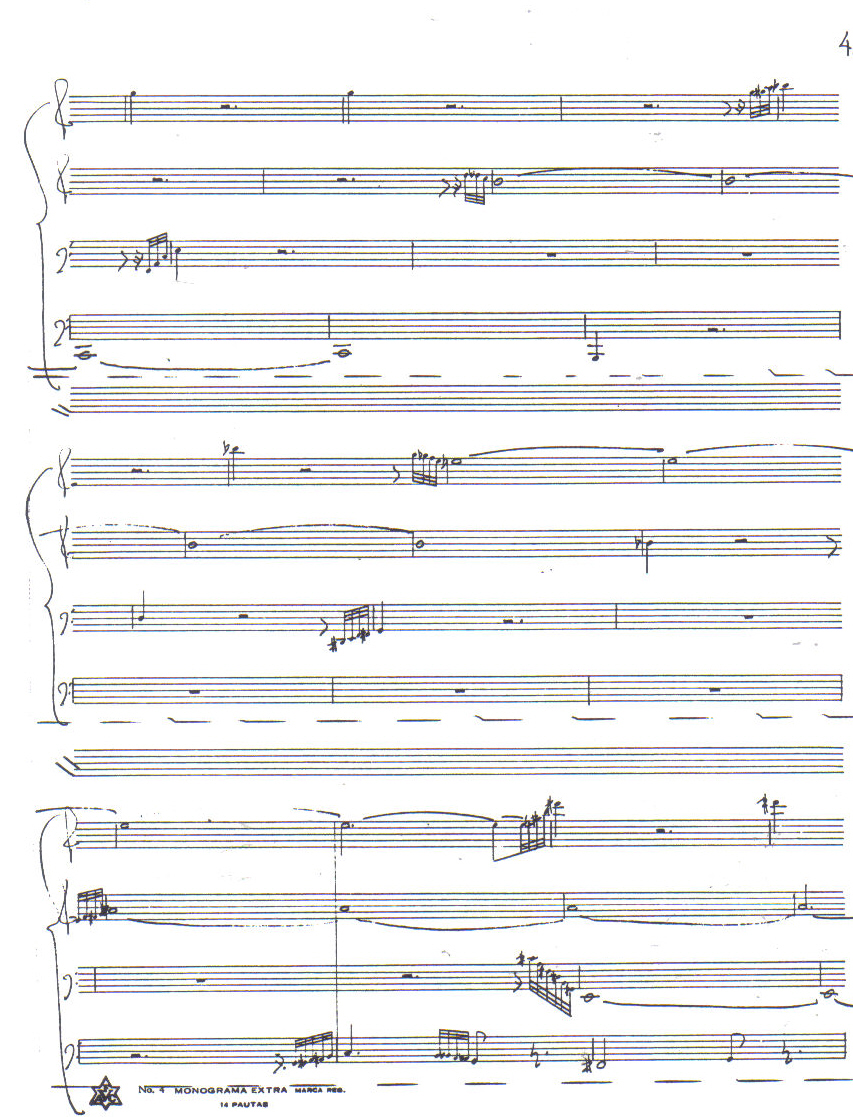
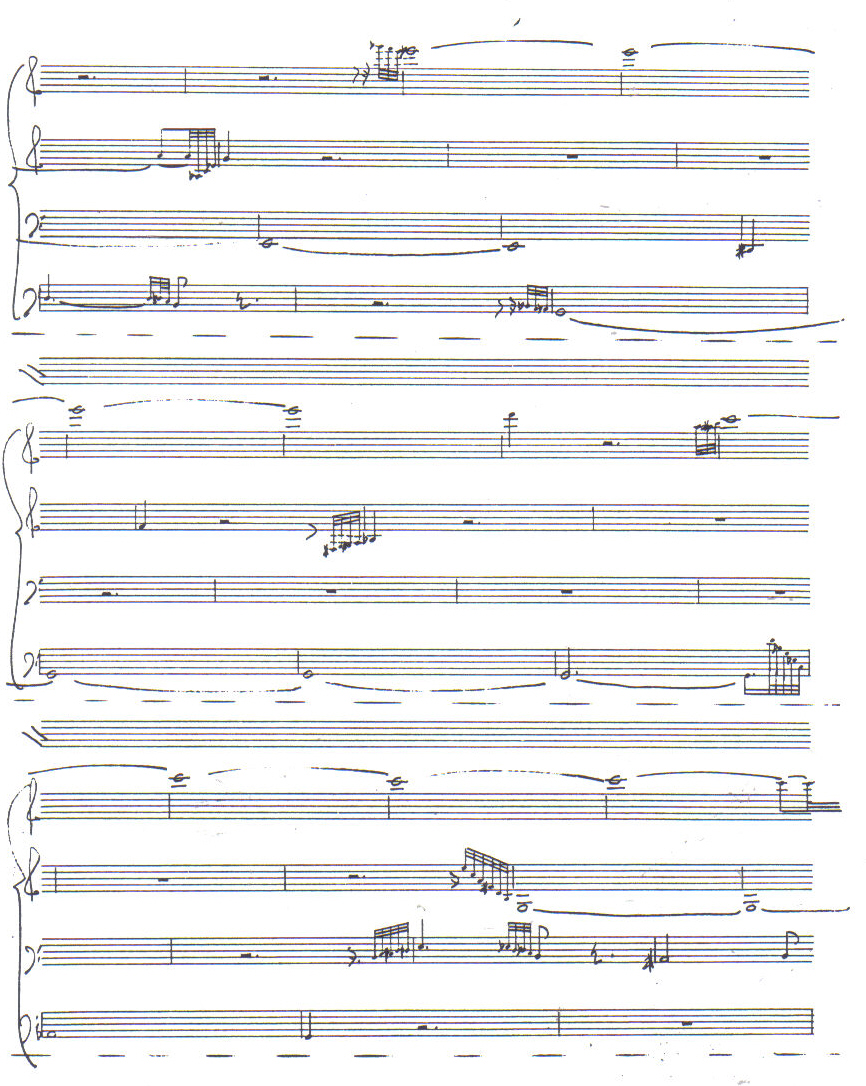
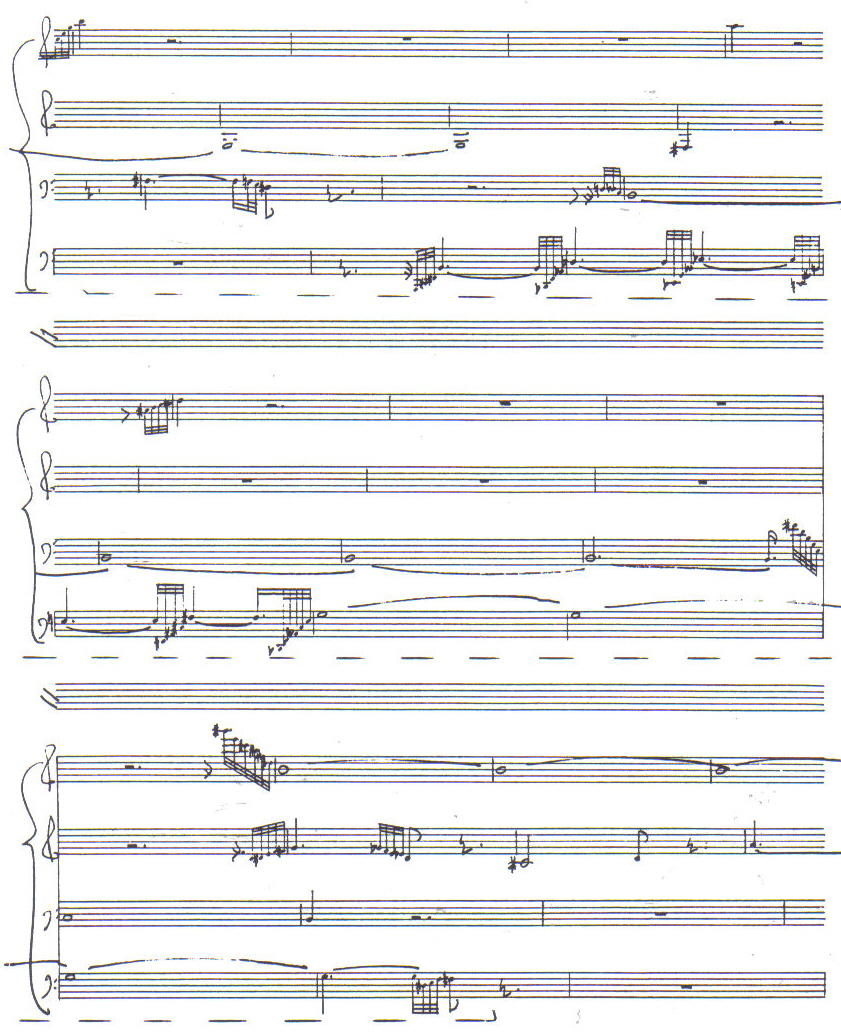
Example 6a: Nancarrow's Canon #36 (17/18/19/20), pp. 4-6
©1977 by Conlon Nancarrow. Used by permission of the publisher,
Soundings Press

Example 6b: Nancarrow's Canon #36 ( 17/ 18/ 19/ 20) Illustration
of Beat Relationships Within a Temporal Cycle
Another work by Nancarrow,
Study #21, utilizes tempo relationships similar to those found in Canon #36. The manipulation of note duration, from shorter to longer
or vice versa, provides the means by which one may achieve a more localized
and more highly control led rate of change. Furthermore, the
temporal changes themselves tend to fluctuate gradually whereas those in Canon #36 were
stable within
each part. The work is subtitled "Canon X." The
designation "X" is a graphic
suggestion
of the temporal crossing by the two lines in the work. In his article
"Conlon Nancarrow's
Studies for Player Piano," James Tenney described
the temporal effect achieved in Canon
X:
The first part (in the bass) begins at a relatively slow
tempo (3.5 notes/second- the numerical values
here and following are my [Tenney's] own estimates).
The second (treble) voice begins, in the next
system, at a very fast tempo (37 notes/second). From
the beginning to the end of the piece the tempo of the first voice gradually increases, while that of the second voice decreases. A little before the half-way point in the
piece the tempos of the two voices "cross", reversing the fast/slow
relationship between them. By the end of the
piece, the originally fast voice has slowed down from its initial 37 notes/second to a tempo of 2.33 notes/second, while
the other voice has accelerated to an incredible
111 notes per second! The tempo\-changes in the course of the piece are linear functions of elapsed time only when
plotted with respect to note-duration (not tempo
as such), which means- among other things that the rate of change of tempo is itself a function of tempo.
That is, the faster the tempo, the faster the rate of
change of tempo.9
The entirety of this work is an ingeniously conceived
illustration of the process of incursion
and excursion in the crossing of parts. Unlike Canon #36, the temporal crossing in this example is very similar to the model for
crossing in the pitch domain.
There is no consistently repeating cycle of temporal relationships between
parts. Therefore, one's sense of expectation is shaped differently. In Canon,
X, the temporal
relationship begins with a relatively high degree of separateness, proceeds towards a point of intersection, and then excurs to an even greater degree of separateness. The effect is made even more pronounced by
the fact that the pitch relationships between the two parts coincide,
precisely with the temporal relationships. The bass part moves from low to high while the treble moves from
high to low. The pitch
crossing occurs at the same time as the tempo crossing. Therefore, Canon X is a rare example of a "double cross" in which two primary
musical elements are structured such that their
deployment produces a synchronized crossing.
In my work Dragon for Orchestra (Example
7a), the effect found in Nancarrow's Canon X is augmented by increasing the number of
musical phenomena affected by
crossing. One part begins very low in the contrabasses and tuba and gradually increases in both the rate of articulation and
upward ascent. The other, glissandi
in the upper strings, begins very high and gradually descends to the contrabasses (at a lower pitch level than that found at the
beginning of the ascending lines). However,
there is not a decrease in the rate of articulation or, in this case, the distance covered as was found in Nancarrow's example. The glissando maintains a strict one
octave per beat rate. Additionally there is a rather consistent one octave cut-off of the high pitch range every measure (this changes to a perfect fourth in measure 200 in order to end the passage on E1 rather than on A). Even though the crossings occur at the half-way point in the passage (between mm. 199 and
200), they are not structured as
precisely as Nancarrow's. This is partially due to
the rather short length of the excerpt
(approximately 16 seconds as opposed to several minutes for Canon X). Under such compressed conditions it was not
considered necessary to achieve a near
exponential increase or decrease in note duration (or tempo). Instead, primary
consideration was placed upon the effect of a rather sudden and quickly achieved pitch and tempo crossing
as well as a crossing of the paths the
sonic materials would traverse through the physical arrangement of the orchestra on stage. Example 7b shows the intended
arrangement of the orchestra. The broken
lines plot the path of the ascending line as it travels from instrument to instrument in the orchestra while the solid line
plots the path of the descending glissandi.
The basic idea is that the descending line moves from the left side of the
orchestra to the right side while the ascending one moves from right to left.
Not only does crossing occur in the
frequency and tempo domains but also in the spatial and the dynamic domains (the ascending line changes
from "p" to "f" and the
descending line from "f" to " p"
). Altogether, this excerpt from Dragon for Orchestra features four concurrently synchronized crossings
of diverse musical elements and/or phenomena.
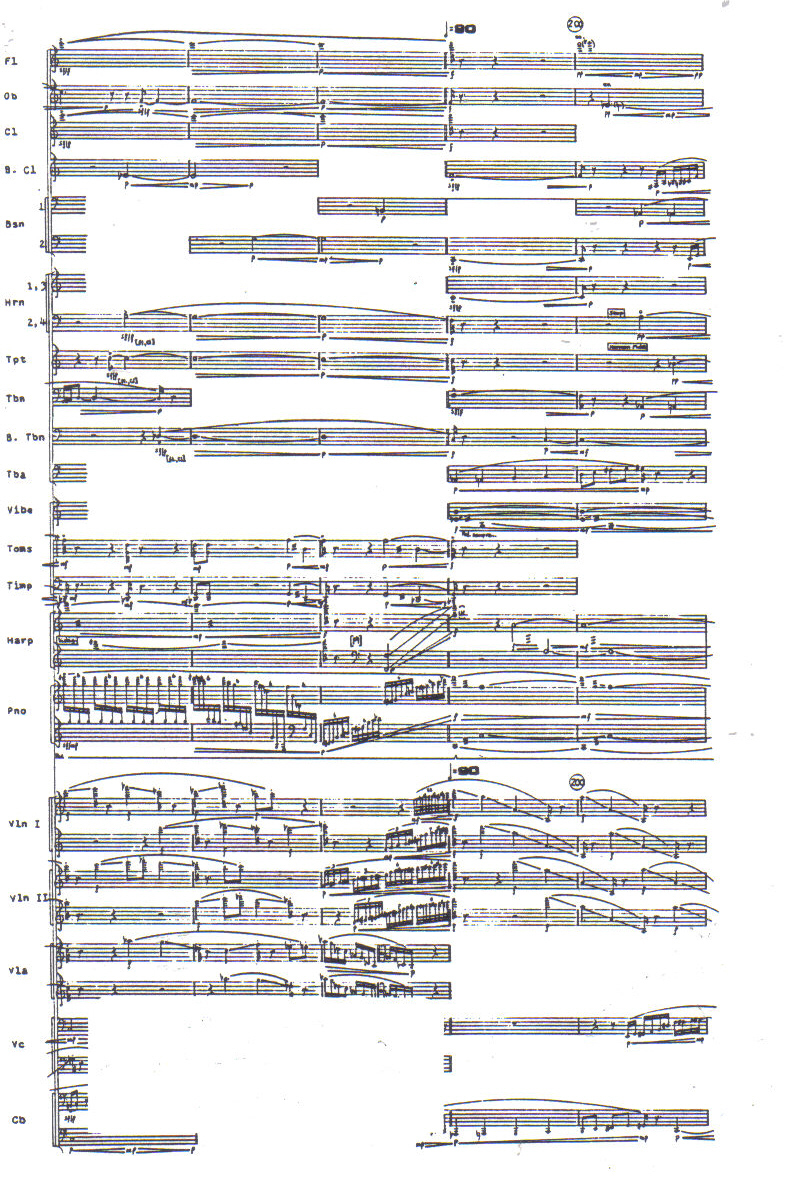
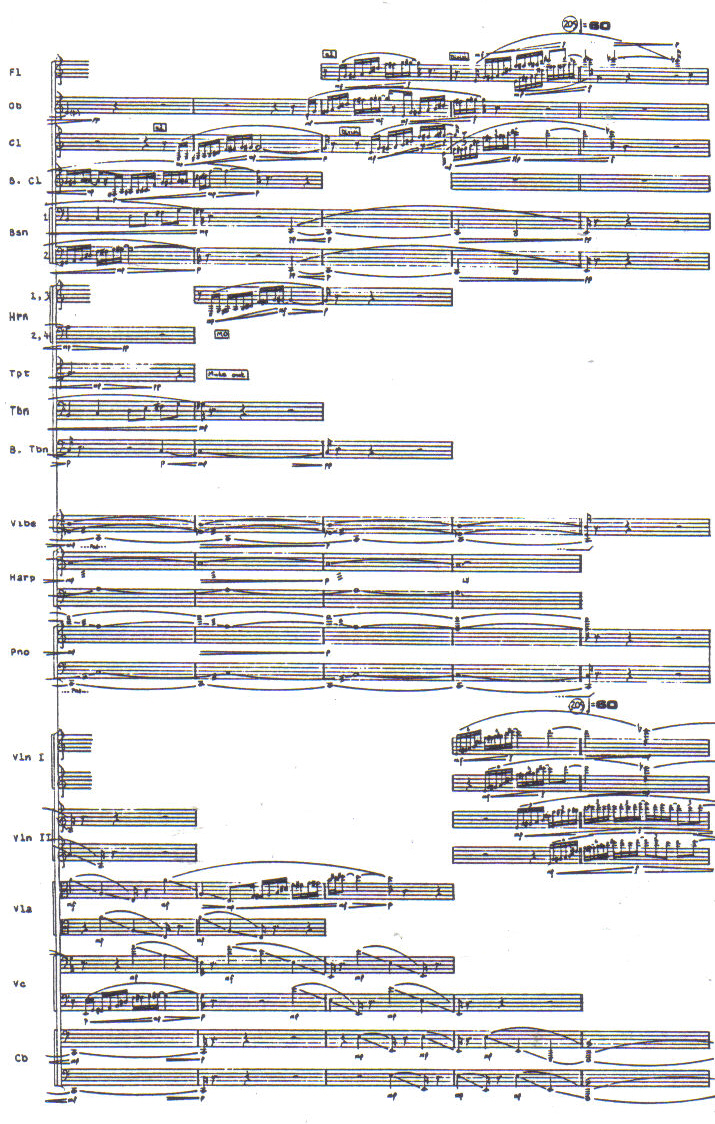
Example 7a:
Gabel: Dragon for Orchestra, mm.
197-206
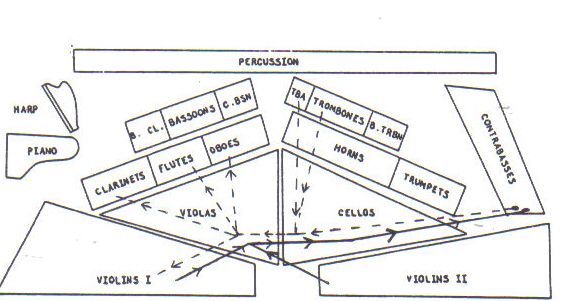
Example 7b:
Orchestral Seating Plan in Dragon for Orchestra
Many of the
examples cited in this paper are from works traditionally performed in
a proscenium arrangement, with the performers arranged in close proximity to one
another facing the audience. The listener is faced with the task of attempting
to isolate and "hear out" lines which are engaged in part crossing
and which emanate from a single spatial locale. If, on the
other hand, the instrumental forces are separated in physical space, the listener may
attend to sounds emanating from more than one location which may enable him/her to
avoid confusion of the functions of crossing parts. This makes it possible for
sounds to be separated in space. This manipulation has emerged as an important
phenomenon in recent compositional
practice.
In several
of his works, • Roger Reynolds utilizes the manipulation of physical and
musical space as a primary structural element. His conception of space as an organizational
element involves the physical dispersement of
performers (or groups of performers) within the performance space. Space is
also utilized as an expanse through which sounds can be passed from one performance
group to another (or from one loudspeaker to another). In Quick Are the
Mouths of Earth, he experiments with three types of spatial interplay between three
groups of performers: 1) clusters of marked entrances which emanate from all locations
within the ensemble; 2) the passing of similar materials from group to group; and 3)
the continuous flow of one sound from left to right (or right to left, etc.) across
the ensemble. The results, though sometimes extremely delicate, and
subtle, are very effective if there is sufficient separation between
the groups of performers.
At measure
62 of his Threshold for orchestra (Example 8a), Reynolds passes a chordal structure intact from the strings to the winds.
However, the designated seating arrangement of the orchestra (Example 8b) shows
that the chord does not move toward the back of the stage (which would have been
the case with a conventional arrangement) but backwards to the horns, back to
the right to the woodwinds, forward to the right to a brass group, and
forward to the left to another brass group. As a result, the chord radiates in
all directions from the center to
the outer periphery of the orchestra. In the interchange from strings to winds,
pitch components of the
chord can be thought to move and cross in space.
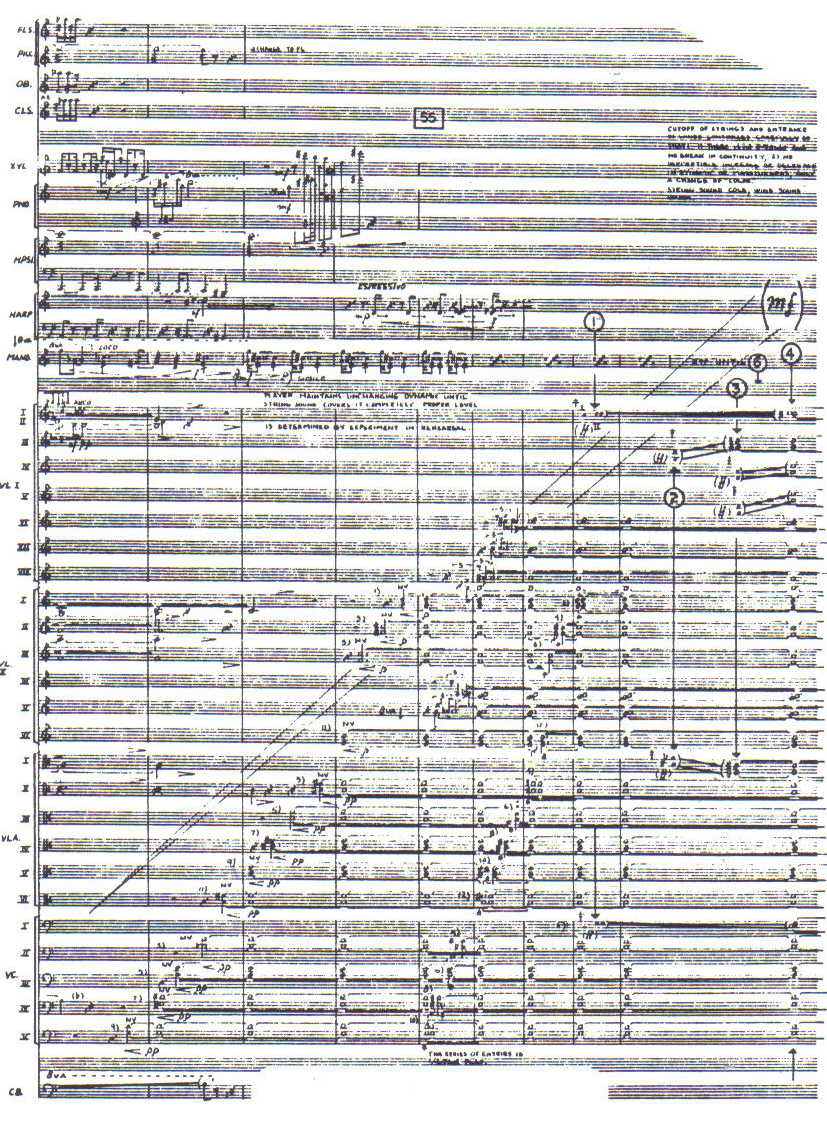
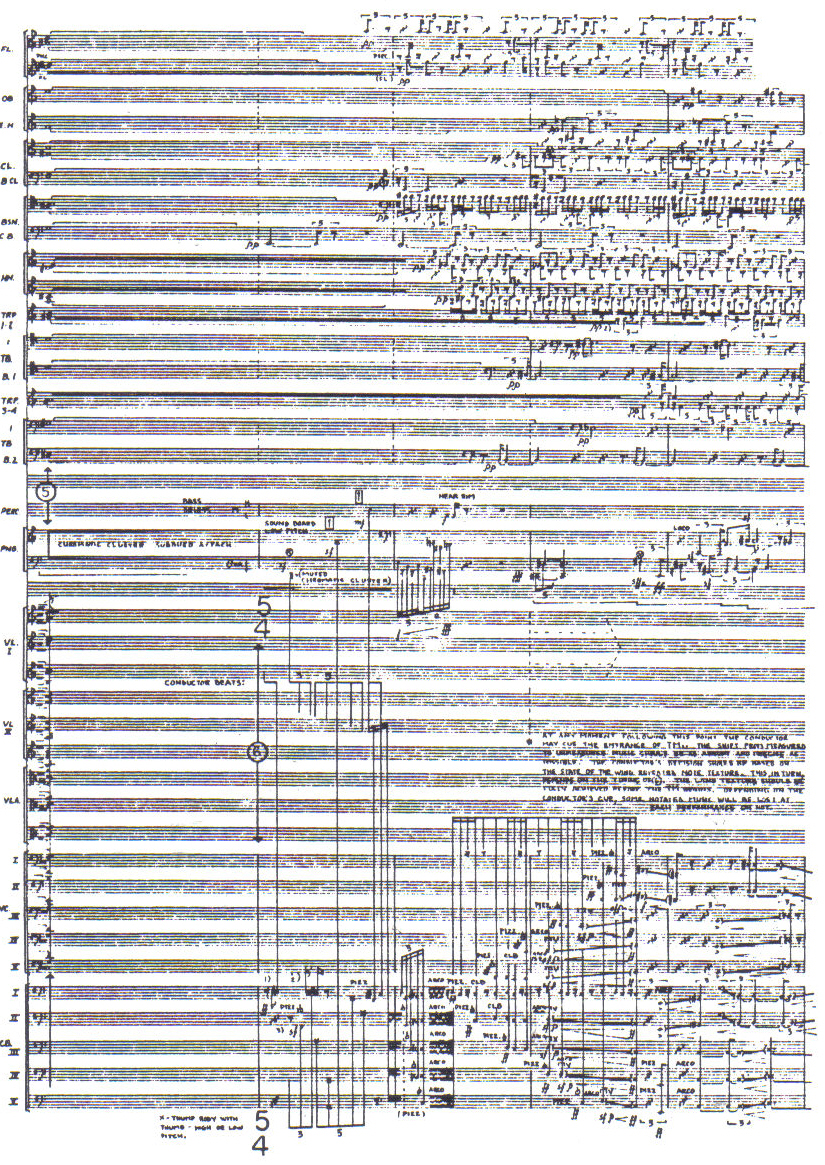
Example 8b:
Reynolds' Threshold pp, 6-7
Copyright ©1969
by C. F. Peters Corporation. Used by
permission.
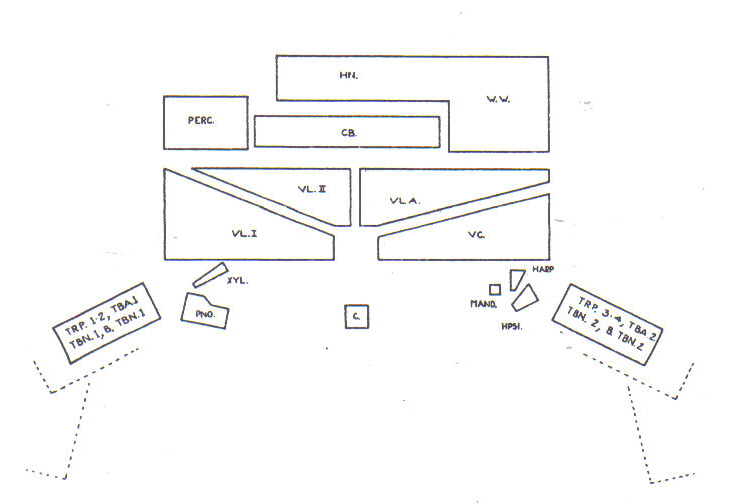
Example 8b:
Orchestral Seating Plan in Threshold
The spatial deployment of performers
is still undergoing experimentation. The electronic media of synthesized and computed sounds emanating from
loud speakers at
various locations within or surrounding a performing space are providing the composer with greater control in working with musical
and physical space than is
possible by conventional means. The manipulation of space is becoming increasingly integrated into the practice of musical composition.
This is partially true because
more sophisticated instruments (computers, tape, loud
speakers) are available.
Perhaps the most ambitous
experiments with the movement of sound in space were carried out recently by Roger Reynolds. While
not specifically researching
the crossing of sounds in space, his work does provide a basis for realizing
greater control of this
phenomenon. He summarizes his thoughts on the manipulation of sound
in space in the article "Interview: Reynolds/Sollberger:"
"RR: The Poeme Electronique [by Edgard Varèse] and Gesang der Junglinge [by Karlheinz Stockhausen} were done with a concern for the spatial
properties of sound. What seems to me
absent there was an effort to discover what it is that constitutes a memorable, perceivable gesture within the field of
movement. In other words, we know that we can
notice the changing of position and the changing of relative size and speed...of sounds. But whether all these patterns of
movement would be equally memorable or equally
perceptible is not known. Nor do we know anything about the impact of changes in the nature of the illusory "host
space" in which the sounds move.
HS:
You're talking now about developing a language or a vocabulary
RR: Yes. Just quantifying, being able to build structures,
to make the spatial properties of sounds and the change of spatial properties
of sounds in some sense a structural
dimension of music in the way that dynamics became, the way that timbre became, to a degree. I think there's no question that
this is in the offing, and that, of course, computers are the key
to that."
10
In his recent works, Reynolds very precisely plots,
calculates, and computes the sound
paths and space functions of sonic events in his compositions. The graphic representation of some of these paths and functions
(Example 9) illustrates the highly complex
nature of the sound paths.
In Archipelago, Reynolds explores a means by which the movement of sound in space can be precisely and effectively simulated. In
discussing the desired effect he writes:
The liquid metaphor I adopted allows one to view sound as
a fluid medium that can emanate from
one point in space, spread out - perhaps surrounding the
listener- and then contract again into a different final position:11
The proposed effect is an illuminating metaphor for sounds
emerging from afar and receding into
the distance. Example 10a illustrates the eight channel speaker configuration which was used for the. premiere of Archipelago at IRCAM in Paris. The use of eight channels, as opposed to the more conventional two or
four channel model, maximizes" the variety of
movement patterns - of paths or shifting
expanses.12
The configuration uses two quadraphonic systems. The upper
system is rotated 90
degrees in relation to the lower system and is located slightly outside the quadrangle formed by the lower system. Reynolds graphs
the sound flow paths of each sound event
(Example10b). This graph illustrates that sounds move between close, normal, or distant references. An important
cue for distance is given by the amount
of reverberation present in the signal. The greater the relative amount of reverberation the greater the sense of distance.
At times 1-2, the sound is distant and
located in the front speaker (refer to Example 10a for speaker location). For times 3-4, the sound is located in the same
speaker but has become more present with
a specification of normal. At times 5-6, the sound spreads out to the front left
and front right speakers with a
continued normal distance cue. For times 7-8, the sound becomes very present in the same two
speakers. Finally, at times 9-10, the sound
moves to the back, back left, and back right speakers, ending in the distance. For times 1-8 the sound not only gets louder but
it also seems to become more present
spatially before quickly "passing" to its final destination at the
rear of the hall.
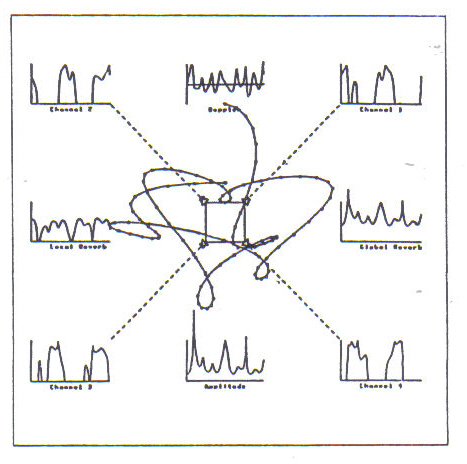
Example 9: Reynolds' Voicespace
IV, The Palace
Location
Sequence Stencil for Pulse Trains
From Roger Reynolds: Profile of a Composer.
©1982 by C. F. Peters
Corporation. Used by permission.
The speaker configuration and its manner of usage in Archipelago
suggests significant potential for the production
of diverse crossing effects. The primary factor is the additional number of speakers from which
sounds may both emanate from and move
toward. Furthermore, the combination of two distinct spatial levels creates a multitude of new possibilities for the
transmission of sound through space. It is possible that Reynolds'
speaker configuration might be a step towards the construction of halls specifically designed for the performance of
electronic and computer generated
music. Such a performance space of the future might have as many as
200-300 speakers13 placed at pre-determined locations in the walls,
ceiling, and floor. Thereby,
the composer would be able to realize a formidable number of spatial
paths. A facility of this type could become a vehicle by which new investigations into
the nature of sounds crossing in space could be realized. Not only would one be able
to conduct extensive research into basic relationships of the spatial crossing
of sounds, but also one might be able to discover those relationships which produce
ultimately effective crossings of sounds in space. These researches could
contribute to the codification of a new musical/theoretical discipline - a
"counterpoint" of sorts based upon the combination of sounds
at various "points" in space. Crossing principles may not prove to be
the only motivating force in the generation of a new
contrapuntal art. However, they will undoubtedly be a topic of importance within the general scope
of "spatial counterpoint."
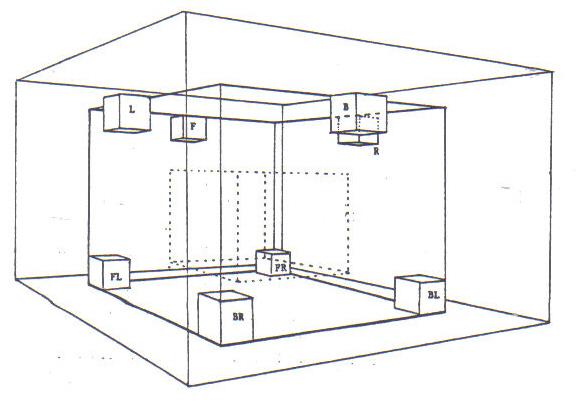
Example
10a: Loud Speaker Configuration in Archipelago
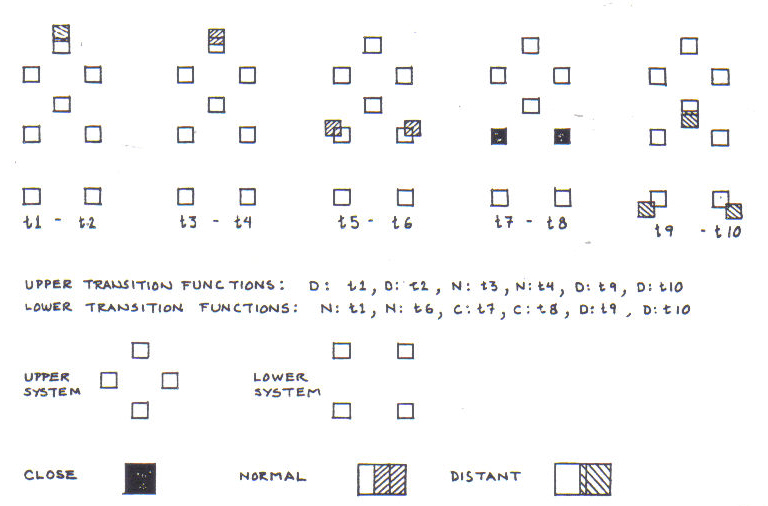
Example
10b: Graphic Specification of a Sound Flow Path in Archipelago
Bibliography
Gabel,
Gerald R., The Effects of Part Crossing Upon
Musical Texture, University
Microfilms, Ann Arbor, Mich., 1984.
Lutoslawski,
Witold, Performance note from Trois
Poemes d'Henri Michaux, Polskie
Wydawnictwo Muzyczne,
Warsaw, Poland, p. 48.
Lutoslawski, Witold, "About the Element of Chance in Music," Three Aspects of New Music, Nordiska Musik Forlaget,
Stockholm, 1968.
Moldenhauer, Hans, and Moldenhauer, Rosaleen, Anton
Von Webern: A Chronicle of His Life and Work, Alfred A. Knopf, New York, 1979.
Reynolds, Roger, "Inexorable Continuities," in Conlon Nancarrow: Selected Studies for Player Piano, Garland, Peter, ed., Soundings Press,
Berkeley, 1977, p. 28.
Reynolds, Roger, "Making a Musical Experiment,"
Unpublished, 1982.
Reynolds, Roger, and Sollberger, Harvey, "Interview: Reynolds/Sollberger," in Roger
Reynolds: Profile of a Composer, C. F. Peters,
Corp., New York, 1982, p. 26.
Tenney, James, "Conlon Nancarrow's
STUDIES for Player Piano," in Conlon Nancarrow:
Selected Studies for Player Piano, Garland,
Peter, ed.,
Soundings Press, Berkeley, 1977.
1 For
example, terraced dynamics are very characteristic of Baroque music and sudden
shifts from soft to loud • and vice versa (the
Sturm und Drang principle) are found in the Classical
period. Gradual transitions from one dynamic level
to another as well as their vastly increased implementation are characteristic
of the Romantic era.
2 For
a detailed discussion of part crossing see the author's "The Effects of
Part Crossing Upon Musical Texture" which
is listed in the bibliography.
3 Leibowitz,
Rene, Schoenberg and His School, Da
Capo Press, New York, 1949, p.43.
4 The
nomenclature for pitches is based upon middle C as C4. Therefore, the C an
octave above middle is called C5. The C an octave
below middle C is called C3.
5 Lutoslawski, Witold, performance note from Trois Poetnes d"Henri
Michaux, Polskie Wydawnictwo Muzyczne,
Warsaw, Poland, p. 48.
6 This refers to Peter Stadlen
who premiered the work on October 30, 1937. Weber coached Stadlen in preparation for
the concert.
7 Moldenhauer, Hans, and Moldenhauer,
Rosaleen, Anton Von Webern:
A Chrw, felt- Hi.s.
Life and Work, Alfred A. Knopf, New York, 1979, p, 484.
8 Reynolds,
Roger, "Inexorable Continuities," in Conlon Nancarrow:
Selected Studies for Player Piano, Garland, Peter,
ed., Soundings Press, Berkeley, Ca., 1977, p. 28.
9
Tenney,. James "Conlon Nancarrow's Studies for Player Piano," in Conlon Nancarrow: Selected
Studies for Player Piano, Garland,
Peter, ed., Soundings Press, Berkeley, Ca., 1977, p.
54.
10 Reynolds, Roger, and Sollberger, Harvey, "Interview: Reynolds/Sollberger," Roger Reynolds: Profile of 4 Composer,
C. F. Peters Corp., New York, 1982,
p. 26. Reynolds, Roger, and Sollberger, Harvey, "Interview: Reynolds/Sollberger," Roger Reynolds: Profile of 4 Composer,
C. F. Peters Corp., New York, 1982,
p. 26.
11
Reynolds,
Roger, "Making a Musical Experiment," Unpublished, 1982, p. 10.
12
Ibid.,
p. 10.
13 There have been installations developed which either
approach or exceed these specifications. In particular, one is reminded of the famous Phillips Pavillion at
the Brussels World's Fair and certain structures developed by lannis Xenakis. However, such
facilities are few in number. It is hoped that, as
the technology is developed, such studios and performance spaces will become
more commonplace.



















